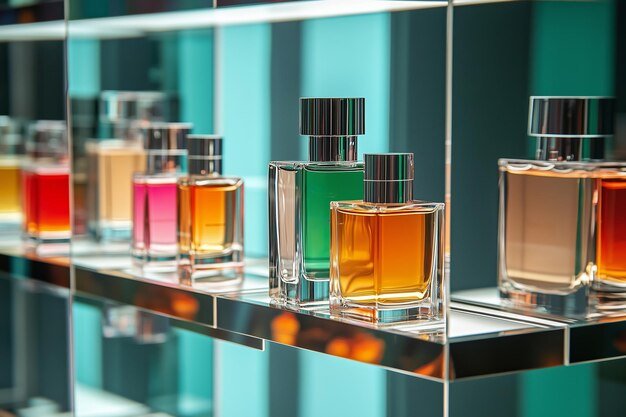In today’s world, barcodes are everywhere, including the fragrance industry. But what exactly is a Código de Barras, and why is it crucial for perfume lovers? This unique identification system plays a vital role in ensuring authenticity and quality in fragrance products.
As consumers, we want to trust what we’re buying. With counterfeit perfumes on the rise, understanding barcodes has never been more important. They not only verify a product’s legitimacy but also provide essential information about its origin and composition.
In this article, we will decode the secrets of Código de Barras in perfumes. From how barcodes function to their impact on your fragrance experience, we’ll cover everything you need to know. Dive in to discover how you can make informed choices and enhance your perfume journey.
Understanding Barcodes: Function and Purpose
Barcodes serve as a fundamental tool for identifying and tracking products. In the perfume industry, they provide essential information about each fragrance. A Código de Barras, or barcode, is a machine-readable representation of data that contains product details, including manufacturer, product type, and more.
Barcodes consist of a series of vertical lines and spaces, each representing a specific number. This simple yet effective design allows scanners to read the information quickly and accurately. Barcodes can vary in type; the most common formats include UPC (Universal Product Code) and EAN (European Article Number). Each format serves similar purposes but is tailored for different markets.
The primary function of a barcode is to streamline the purchasing process. Retailers scan the barcode at the point of sale, which helps track inventory and sales data. For consumers, this means faster checkouts and accurate pricing.
In addition to streamlining sales, barcodes enhance product traceability. If a fragrance has quality issues, the barcode can reveal its batch number and production date. This information allows manufacturers to address problems swiftly and efficiently, protecting consumers from faulty products.
Barcodes also play a key role in verifying authenticity. In a market flooded with counterfeit perfumes, being able to scan a barcode can help consumers confirm that they are purchasing genuine products. Many brands provide online databases where customers can input the barcode to access detailed product information.
Overall, barcodes are integral to the perfume industry. They simplify transactions, improve product tracking, and assist in authenticity verification. Understanding their function and purpose can enhance your experience as a consumer, making it easier to enjoy your favorite fragrances with confidence.
The Role of Barcodes in Authenticity and Quality Assurance
Barcodes play an essential role in verifying the authenticity of perfumes. In a market that increasingly faces challenges from counterfeit products, understanding how barcodes function can help consumers make informed purchasing decisions.

When you scan a perfume’s barcode, it can provide critical information about the product’s origin. Many reputable brands offer online tools where consumers can input the barcode number. This process reveals whether the fragrance is genuine and confirms its production details. Scanning allows consumers to compare the information with what is presented on the packaging. If discrepancies arise, this may indicate a counterfeit.
Quality assurance begins at the manufacturing level. Each batch of perfumes is assigned a unique barcode. This barcode correlates with specific production information, including ingredients, production date, and location. If any issues occur, such as a recall or quality complaint, manufacturers can quickly trace the affected batch using the barcode. This traceability helps protect consumers and maintains brand integrity.
Consumers can also look for specific features on the packaging that accompany the barcode. For example, many brands include holograms or additional security labels alongside barcodes to further verify authenticity. These extra layers of protection provide assurance against counterfeit products, giving customers added confidence in their purchases.
Retailers also benefit from barcodes. When fragrances are scanned at the point of sale, the system tracks sales and inventory. This data helps retailers identify which products are popular and which may need to be examined for quality issues. Effective inventory management relies on accurate barcode data, facilitating a more organized retail environment.
In summary, barcodes are vital in maintaining authenticity and quality in the perfume industry. They provide a straightforward method for consumers to verify products, while also offering manufacturers a way to manage quality and traceability. Understanding the importance of barcodes can empower consumers, allowing them to make more confident choices when purchasing fragrances.
Deciphering Fragrance Information from Barcodes
Understanding how to read barcodes on perfume bottles is key to gaining insight into the fragrance’s details. A barcode not only serves as an identifier but also encapsulates important information about the product.
The most common barcode formats you will encounter are the Universal Product Code (UPC) and the European Article Number (EAN). Each format consists of a series of numbers corresponding to specific product attributes. When you scan a barcode, the scanner reads the encoded numbers and retrieves data from a database that contains details about that particular perfume.
The information linked to a barcode typically includes the manufacturer’s name, product type, and sometimes even the specific fragrance notes. This data is crucial for consumers who want to learn more about the perfumes they purchase. Many brands have started to offer online tools where consumers can enter the barcode to view this information directly.
In addition to basic product information, barcodes can provide insight into batch codes and production dates. Each perfume batch is assigned a unique code that indicates when and where it was produced. This feature is beneficial for consumers looking to verify the freshness and authenticity of their fragrances. Knowing the production date can also help in understanding the scent’s longevity and stability over time.
When it comes to decoding fragrance profiles, barcodes can guide you to specific notes. While the barcode itself might not display scent notes directly, accessing the product information through online tools can reveal whether a fragrance is composed of citrus, floral, or woody notes, for instance. This understanding can enhance your selection process, allowing you to choose scents that align with your preferences.
Lastly, understanding how to read barcodes helps in identifying potential counterfeit products. If a perfume’s barcode does not match the information provided on the manufacturer’s website, it may raise a red flag. This scrutiny protects consumers from purchasing fake or low-quality fragrances that do not meet brand standards.
In summary, barcodes are more than just lines and numbers; they are gateways to a wealth of information about perfumes. Learning how to interpret this data allows consumers to make educated decisions about their fragrance purchases, ensuring they enjoy the best quality products.
Enhancing the Consumer Experience
Barcodes significantly enhance the consumer experience in the fragrance market by providing vital information and tools for better decision-making. With the rise of online shopping and the prevalence of counterfeit products, understanding how to utilize barcodes can greatly influence your purchasing choices.
One of the primary advantages of barcodes is the ability to verify authenticity. Many reputable brands provide platforms where customers can enter a barcode number to confirm the legitimacy of their purchase. This function is especially valuable for high-end fragrances, where counterfeit products may pose a risk to quality and safety. By checking the barcode before completing a purchase, you can feel more confident that you are getting a genuine product.
In addition to authenticity checks, barcodes offer insights into the fragrance’s composition. Scanning the barcode can lead you to information about the notes used in the perfume. This can include details on top, middle, and base notes, allowing consumers to select fragrances that match their personal preferences. Understanding these elements can transform the fragrance selection process, making it more tailored and enjoyable.
Another way barcodes improve the consumer experience is through inventory management. Retailers utilize barcode technology to track product availability. When shopping in stores, you may find that staff can quickly access product information using a scanner. This efficiency can lead to a smoother shopping experience, as employees can quickly assist you with stock inquiries or locate specific items.
Mobile applications that feature barcode scanning capabilities are becoming increasingly popular among fragrance enthusiasts. These apps allow consumers to scan a perfume’s barcode directly from their smartphones. The app then provides detailed information about the fragrance, including user reviews, ingredient lists, and even suggestions for complementary scents. This level of accessibility makes it easier than ever to make informed decisions while shopping.
Additionally, barcodes can assist in the realm of loyalty programs and promotions. Many brands incorporate barcode scanning into their marketing strategies, allowing customers to earn points or discounts through their purchases. This integration not only enhances customer engagement but also encourages brand loyalty.
Overall, barcodes serve as a powerful tool for consumers in the fragrance market. They provide assurance of authenticity, valuable information about fragrance composition, and streamline the shopping experience. By taking advantage of barcode technology, consumers can navigate the perfume landscape with greater ease and confidence, leading to a more fulfilling fragrance journey.
Fragrance Composition and Decoding
Understanding fragrance composition is key to appreciating perfumes fully. Each fragrance consists of three main components: top notes, middle notes, and base notes. These layers work together to create a complex scent profile that evolves over time.

Top Notes
Top notes are the initial scents you perceive when you first apply a fragrance. They are typically light and volatile, lasting only a short period, usually around 15 to 30 minutes. Common examples of top notes include citrus scents like lemon and bergamot, as well as lighter fruits and herbs. Their role is to create a positive first impression and draw the wearer in.
Middle Notes
After the top notes fade, the middle notes emerge. Also known as heart notes, they form the core of the fragrance and last longer than top notes, typically lasting from 30 minutes to several hours. Middle notes add depth and richness to the scent. Floral and spice notes, such as jasmine, rose, or cinnamon, often dominate this layer. The balance between the top and middle notes is crucial for the overall character of the fragrance.
Base Notes
The final layer, base notes, provides the lasting impression of the perfume. These notes are rich, deep, and typically consist of heavier materials that can linger on the skin for several hours or even days. Common base notes include vanilla, musk, amber, and various woods. This layer adds complexity and warmth, creating a well-rounded fragrance experience.
Barcodes play a supporting role in this process by providing information that helps consumers understand the composition of a fragrance. When a barcode is scanned, it can lead to details about the specific notes included in the perfume. Knowing the ingredients can help consumers choose scents that resonate with their preferences, whether they lean toward floral, fruity, or woody profiles.
In addition to ingredient transparency, barcodes contribute to informed purchasing decisions. With the ability to access detailed information about a fragrance, consumers can avoid scents that might not align with their tastes. For example, if a consumer dislikes floral fragrances, knowing that a particular perfume features rose as a middle note can guide them away from that option.
Learning about fragrance composition also encourages a deeper appreciation of the artistry involved in perfumery. The skillful blending of top, middle, and base notes creates a symphony of scents that can evoke emotions and memories. By understanding how these layers interact, consumers can make more thoughtful choices and enhance their overall fragrance experience.
In summary, recognizing the components of fragrance composition—top, middle, and base notes—enriches the consumer’s journey in the world of perfumes. Barcodes facilitate this understanding by providing access to important details about the scents being purchased, allowing for a more personalized and enjoyable experience.
Technological Advancements in Fragrance Identification
The fragrance industry has witnessed remarkable technological advancements that enhance the way consumers interact with perfumes. These innovations not only improve the purchasing experience but also enhance product transparency and quality assurance.
One significant development is the use of sophisticated barcode technology. Barcodes have evolved from simple numeric identifiers to complex systems capable of holding extensive product information. Advanced scanning techniques allow retailers and consumers to access details about fragrance notes, production dates, and authenticity quickly. This shift enables consumers to make informed choices based on real-time data.
Mobile applications have also transformed how individuals engage with perfumes. Many apps now include barcode scanning features that allow users to obtain detailed information about a fragrance with a quick scan. This includes scent profiles, user reviews, and pricing comparisons across different retailers. With the convenience of smartphones, consumers can access a wealth of information at their fingertips, enhancing the shopping experience significantly.
Another notable innovation is the integration of augmented reality (AR) in the fragrance market. Some brands are experimenting with AR to provide interactive experiences. For instance, customers can use their smartphones to visualize how a scent might smell or see a 3D representation of the fragrance notes. This engaging technology makes the process of selecting a perfume more dynamic and personalized.
Quality control has also benefited from technological advancements. Manufacturers use barcodes to track production batches and monitor quality throughout the supply chain. This system enables quick identification of any issues, ensuring that only high-quality products reach consumers. If a defect is detected, companies can trace back to the specific batch and implement necessary corrective measures.
Data analytics has emerged as another powerful tool in the fragrance industry. By analyzing consumer purchasing patterns and preferences, brands can tailor their offerings to better meet market demands. This insight helps companies innovate and create fragrances that resonate with consumers, improving overall satisfaction.
Sustainability is becoming a priority as well, with some brands employing technology to develop eco-friendly packaging and production methods. Barcodes can play a role in tracking the sustainability of products, providing consumers with information about the environmental impact of their fragrance choices.
Overall, technological advancements in fragrance identification are reshaping the consumer experience. From enhanced barcode systems to mobile applications and AR, these innovations empower consumers with knowledge and confidence in their fragrance purchases. As technology continues to evolve, the fragrance industry will likely see even more exciting developments that further enrich the journey of scent exploration.
Cultural and Market Impact of Barcodes in Perfumery
Barcodes have transformed not only how perfumes are sold but also how they are perceived within cultural contexts and market dynamics. Their impact is felt across various aspects of the fragrance industry, influencing consumer behavior, brand strategies, and overall market trends.
In the cultural landscape, the significance of barcodes extends beyond mere identification. They symbolize authenticity and quality in a world where counterfeit products can undermine consumer trust. This growing awareness has led consumers to prioritize brands that incorporate robust barcode systems, as these systems often indicate a commitment to transparency and reliability. As a result, consumers are more likely to choose fragrances from brands that emphasize authenticity in their marketing strategies.
Additionally, barcodes contribute to the storytelling aspect of fragrances. Many brands use the information linked to barcodes to communicate their heritage, production methods, and ingredient sourcing. This narrative helps establish a deeper connection with consumers who value quality and craftsmanship. By showcasing their commitment to authenticity through barcode technology, brands can foster loyalty and attract discerning customers.
The market impact of barcodes is also profound. They have streamlined the supply chain, making it easier for retailers to manage inventory and track sales. This efficiency helps brands respond quickly to changing consumer preferences. For example, if a particular fragrance gains popularity, retailers can easily identify which products need restocking and which are underperforming. This agility allows brands to adapt their offerings based on real-time data, enhancing their competitiveness in the market.
Moreover, the ability to track sales data through barcodes provides valuable insights into consumer preferences. Brands can analyze purchasing trends, demographic information, and regional differences, enabling them to tailor marketing campaigns and product launches more effectively. By understanding what consumers want, brands can create fragrances that resonate with their target audience, ultimately driving sales and brand loyalty.
Sustainability also plays a role in how barcodes impact the market. With increasing awareness of environmental issues, consumers are seeking brands that prioritize eco-friendly practices. Barcodes can help track the sustainability of ingredients and packaging, allowing consumers to make informed choices that align with their values. Brands that effectively communicate their sustainability efforts through barcodes can differentiate themselves in a crowded marketplace.
Finally, barcodes have facilitated the rise of online shopping in the fragrance industry. With the growing trend of e-commerce, consumers expect to find detailed information about products before making a purchase. Barcodes provide a way to deliver that information quickly and accurately, enhancing the online shopping experience. As more consumers turn to online platforms for their fragrance needs, brands that leverage barcode technology are better positioned to succeed.
Overall, the cultural and market impact of barcodes in perfumery is multifaceted. They enhance authenticity, streamline operations, and contribute to a brand’s narrative, all while shaping consumer expectations and preferences. As the fragrance industry continues to evolve, barcodes will remain an essential tool for brands aiming to thrive in a competitive landscape.
Future Prospects of Barcode Use in Perfume
The future of barcode technology in the perfume industry is poised for significant advancements, reflecting broader trends in technology and consumer preferences. As the market continues to evolve, several key developments are likely to shape how barcodes are used and perceived in the fragrance sector.

Enhanced Transparency and Consumer Engagement
With growing consumer demand for transparency, brands are expected to incorporate more detailed information into their barcode systems. This could include not just basic product details but also sourcing information, ethical production practices, and environmental impact. By providing consumers with this level of insight, brands can foster trust and build deeper connections with their audience. Enhanced transparency may also encourage consumers to make more informed choices that align with their values.
Integration of Smart Technology
The integration of smart technology into barcode systems is another promising avenue. For instance, QR codes could supplement traditional barcodes, allowing consumers to access a wider range of information through their smartphones. This could include interactive content, such as videos explaining the fragrance creation process or user testimonials. Such features could make the shopping experience more engaging and informative, appealing to tech-savvy consumers.
Augmented Reality (AR) Applications
As augmented reality continues to gain traction in various industries, its application in perfumery may enhance the consumer experience. Imagine scanning a perfume’s barcode and being transported to an interactive platform where you can virtually explore the fragrance’s notes or see how it is made. This could not only provide entertainment but also deepen understanding and appreciation of the product.
Sustainability Tracking
Sustainability will remain a priority for consumers, and barcodes can play a critical role in this aspect. Future barcodes may include features that track the sustainability of ingredients used in perfumes. By scanning a product, consumers could see whether the materials are sourced responsibly and whether the packaging is eco-friendly. This capability would cater to the increasing demand for sustainable products and encourage brands to adopt greener practices.
Evolving Retail Environments
As retail environments change, barcodes will likely evolve to meet new consumer needs. For example, the rise of omnichannel shopping—where consumers interact with brands through multiple platforms—requires seamless integration of barcode technology. Retailers might use barcodes to synchronize inventory between online and physical stores, ensuring that customers have consistent access to product information regardless of where they shop.
Data Analytics and Personalization
The use of data analytics will become increasingly sophisticated, allowing brands to tailor their offerings based on consumer preferences revealed through barcode scanning. This data can provide insights into buying habits, enabling companies to create personalized marketing campaigns and product recommendations. Such customization can enhance customer satisfaction and loyalty, driving sales growth.
Protection Against Counterfeiting
As counterfeiting remains a challenge in the fragrance industry, advancements in barcode technology will be vital for improving product security. Future barcodes may incorporate features such as holograms or unique identifiers that are difficult to replicate. This would make it easier for consumers and retailers to verify authenticity, further protecting the integrity of the brand.
The future prospects for barcode use in perfume indicate a shift toward greater transparency, engagement, and security. As technology continues to evolve, barcodes will become an integral part of the consumer experience, influencing how fragrances are marketed, purchased, and appreciated. Brands that adapt to these changes will likely thrive in a competitive landscape, catering to the needs and desires of modern consumers.
Conclusion
The exploration of Código de Barras in the perfume industry reveals its profound significance in enhancing consumer experience and ensuring product authenticity. As technology evolves, barcodes will continue to play a pivotal role in shaping how fragrances are marketed and perceived. They not only facilitate transparency and trust between consumers and brands but also provide essential information about fragrance composition and sourcing practices. With advancements in technology, such as augmented reality and smart features, the future of barcode usage promises to be even more engaging and informative. By embracing these innovations, consumers can make confident choices, while brands can strengthen their relationships with their audience. Ultimately, understanding and utilizing barcodes empowers fragrance enthusiasts to enjoy their scent journeys with greater assurance and appreciation.
FAQs
- What is Código de Barras in perfume?
Código de Barras, or barcode, in perfume refers to a machine-readable code printed on fragrance packaging. It contains essential information about the product, such as the manufacturer, product type, and authenticity, helping consumers verify the legitimacy of the fragrance. - How can I verify the authenticity of a perfume using its barcode?
To verify a perfume’s authenticity, you can scan the barcode using a mobile app or enter the code on the manufacturer’s website. This will provide detailed information about the product, allowing you to confirm if it matches the brand’s records. - What information can I find by scanning a perfume’s barcode?
Scanning a perfume’s barcode can reveal various details, including the fragrance notes, production date, batch number, and sometimes even user reviews. This information helps consumers make informed decisions about their purchases. - Why is fragrance composition important in choosing a perfume?
Understanding fragrance composition, which includes top, middle, and base notes, helps consumers select scents that align with their preferences. Knowing the layers of a fragrance can enhance the overall experience and satisfaction with the product. - What are some future trends in barcode technology for perfumes?
Future trends may include enhanced transparency about ingredient sourcing, integration of augmented reality for interactive experiences, and improved sustainability tracking. These advancements aim to provide consumers with more information and a deeper connection to the products they purchase.











